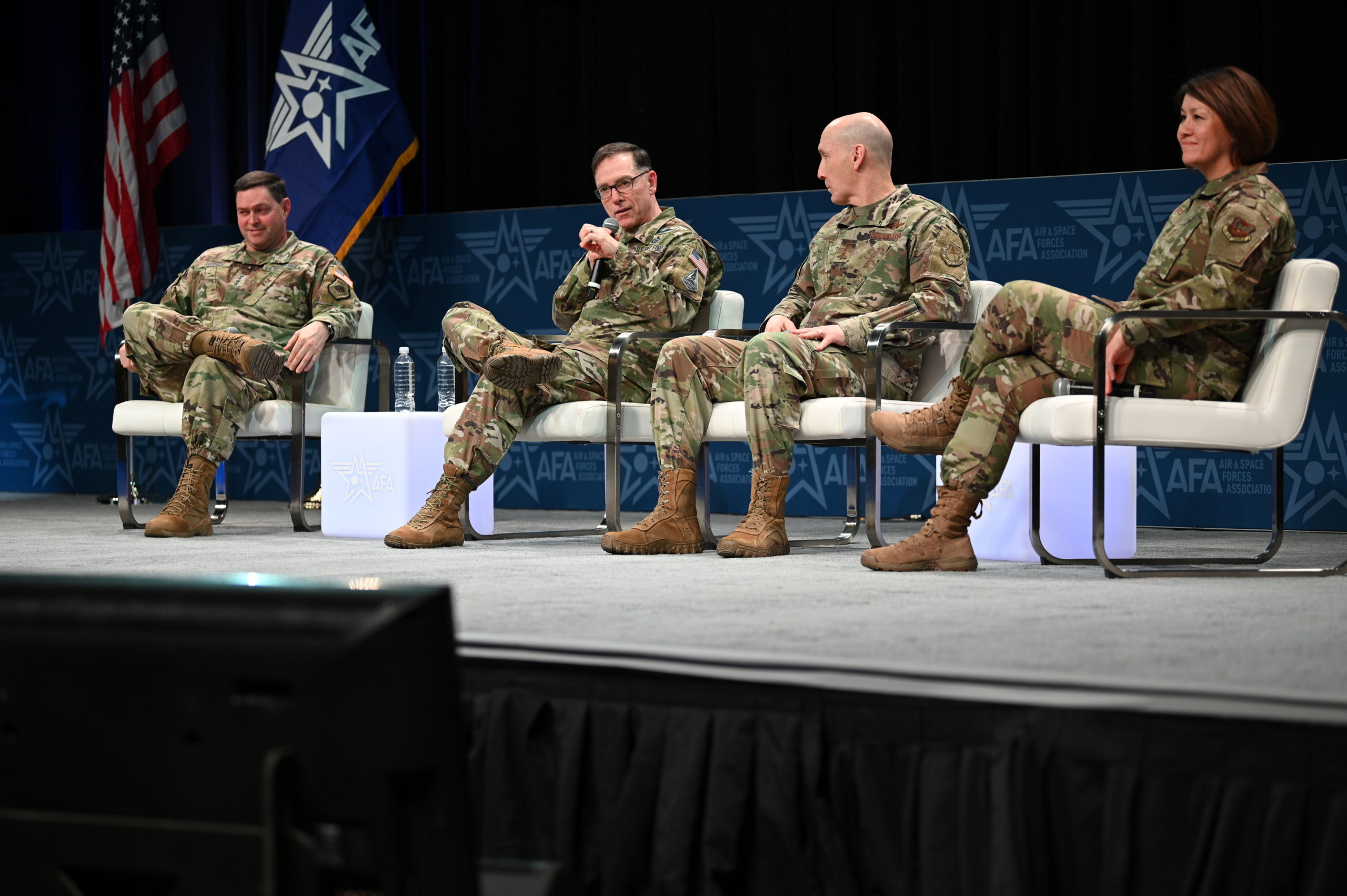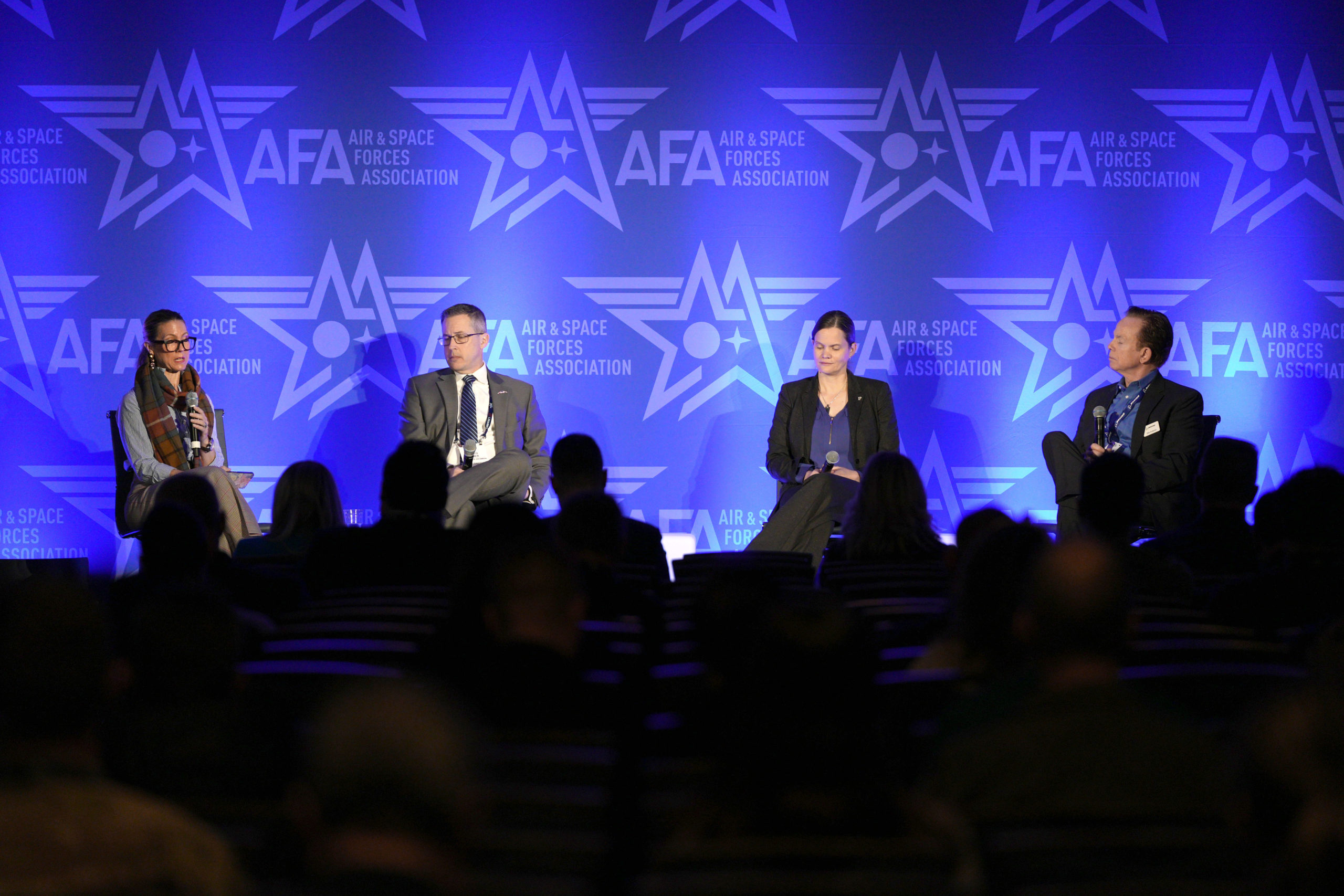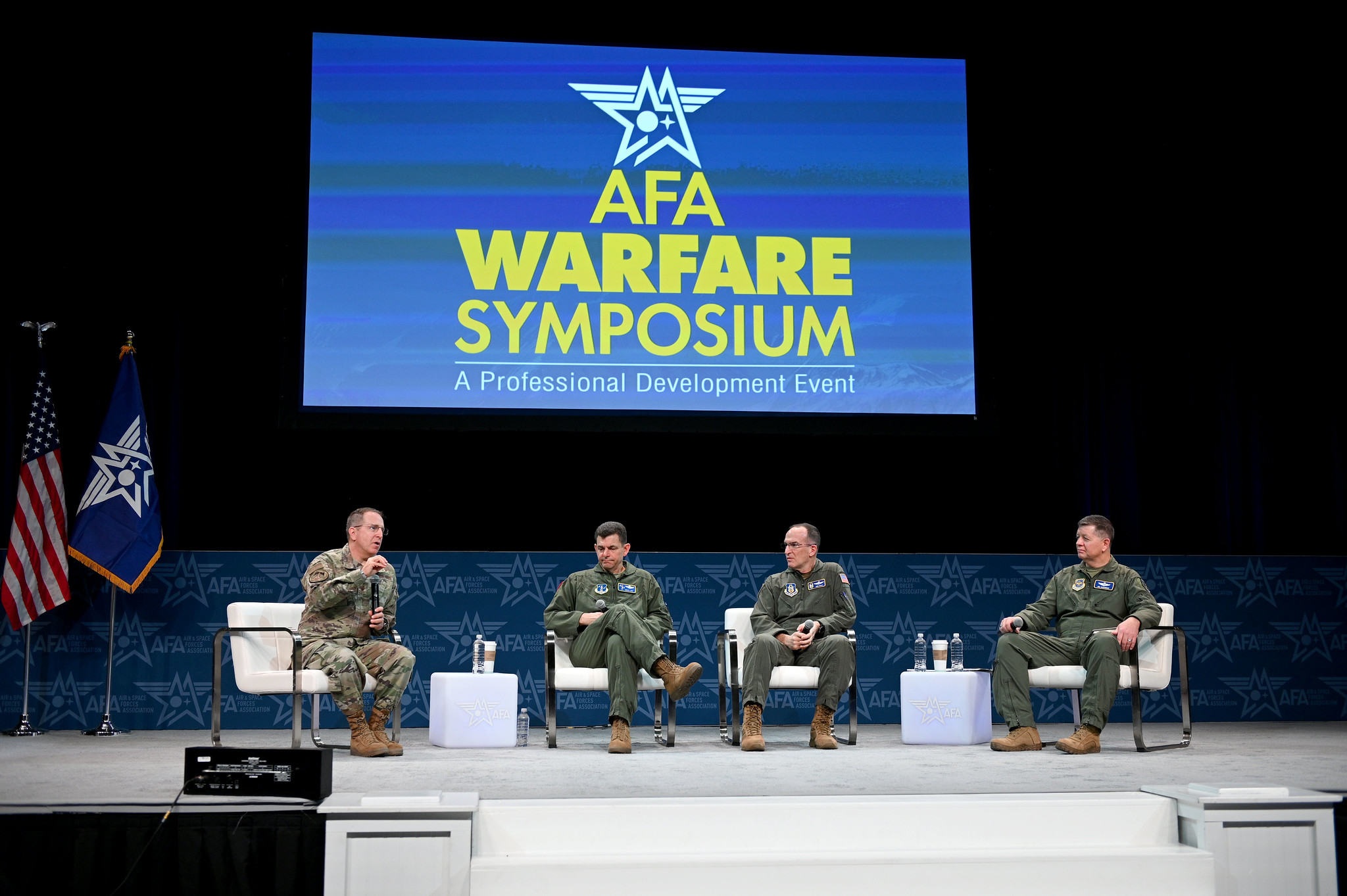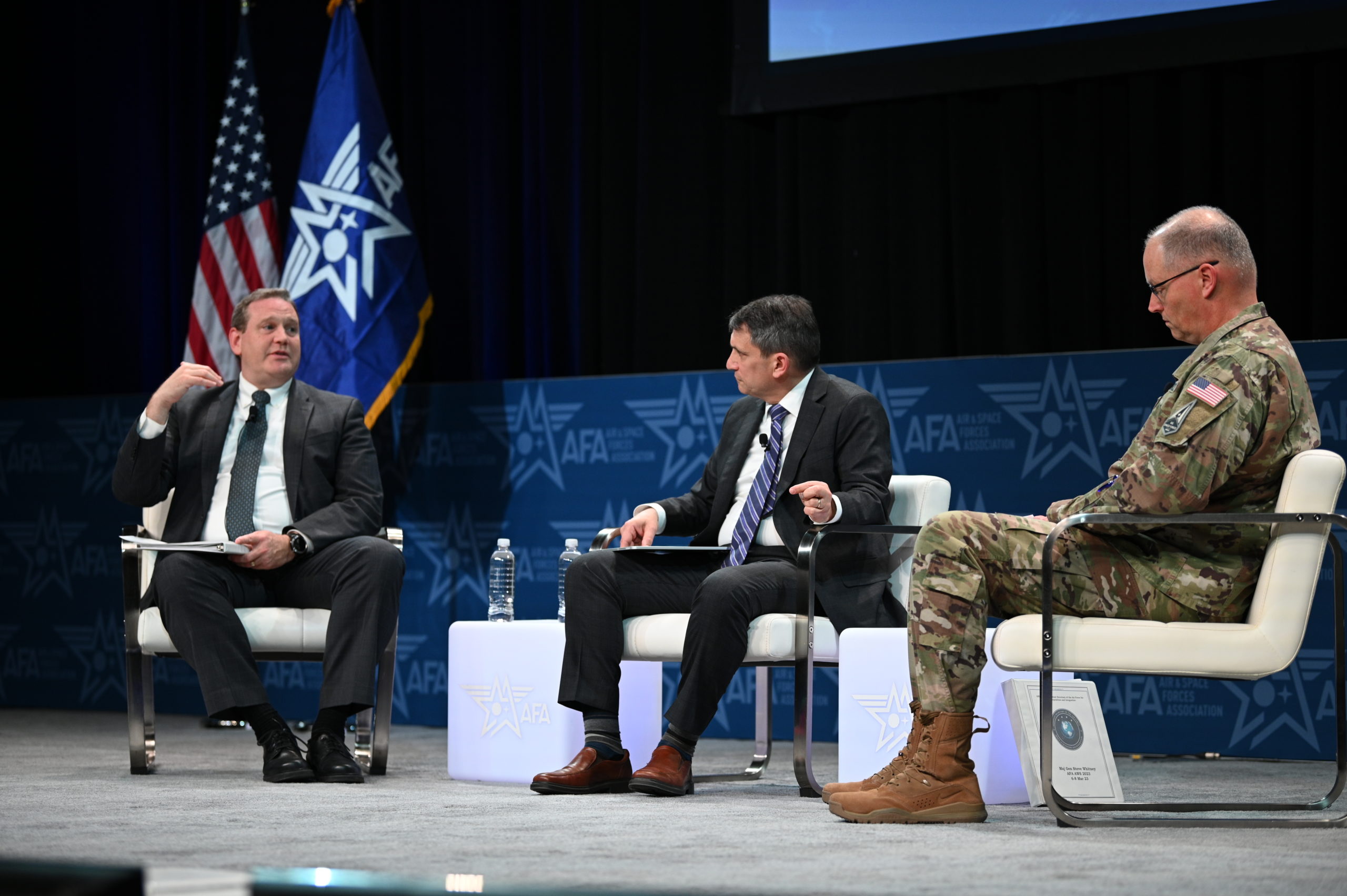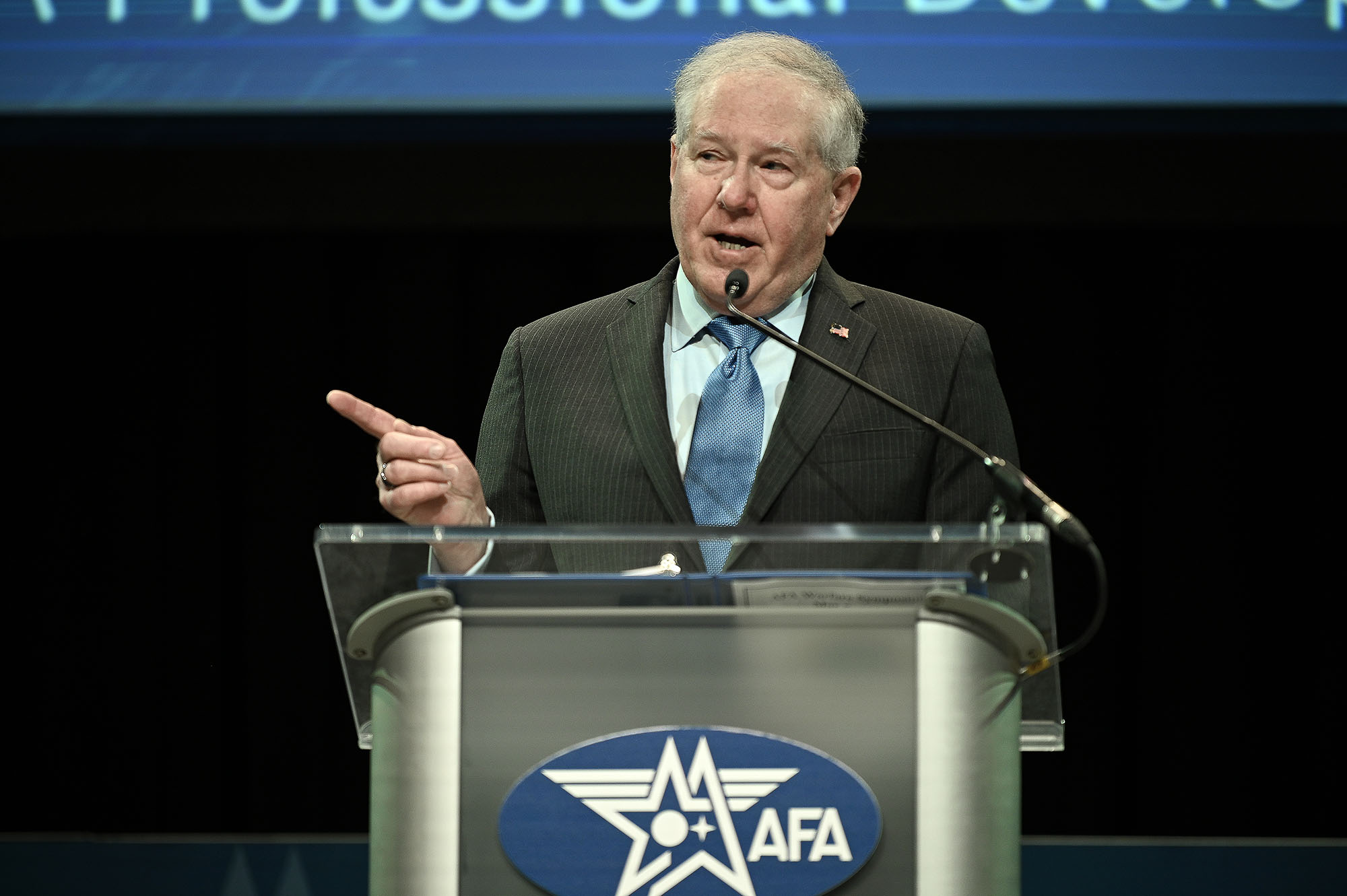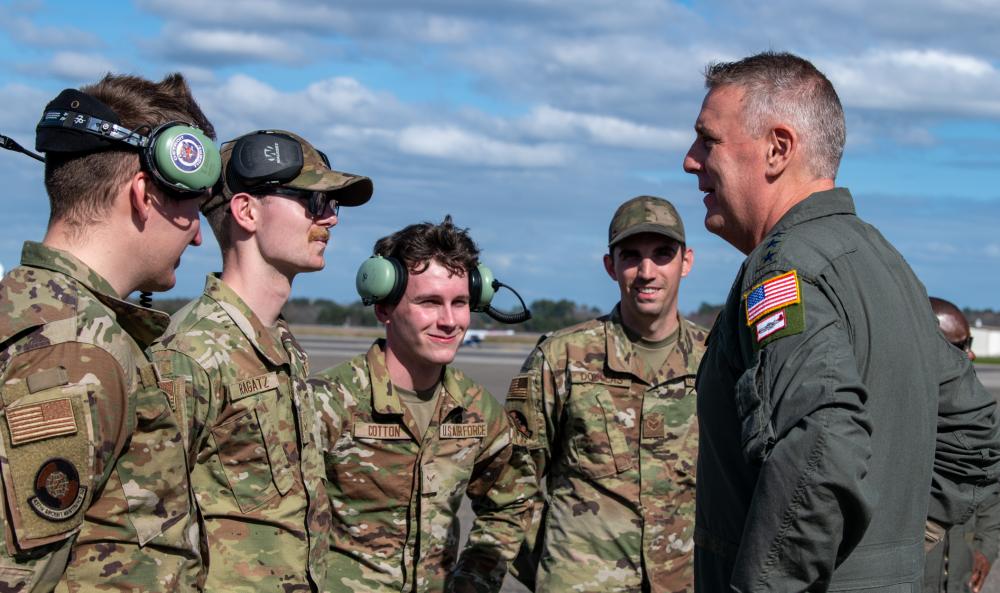AURORA, Colo.—In the face of polls showing fewer and fewer young Americans interested in serving in the military and headlines highlighting issues within the services, senior Air Force and Space Force leaders gave impassioned pleas for Airmen and Guardians to challenge existing narratives about military service at the AFA Warfare Symposium on March 6.
Chief of Space Operations Gen. B. Chance Saltzman, Vice Chief of Staff of the Air Force Gen. David W. Allvin, Chief Master Sergeant of the Space Force Roger A. Towberman, and Chief Master Sergeant of the Air Force JoAnne S. Bass each addressed the issue in a panel discussion, all recalling their own reasons for joining the military.
Continuum of Service
Noting that he was addressing an audience full of Airmen, Guardians, and others who have already chosen to serve, Saltzman stressed the importance of service members and veterans “telling stories” to highlight the positive impacts military service has had on their lives and opportunities over time.
“I think it’s important to recognize that the things that maybe get you into service aren’t the reasons you stay,” Saltzman said. “And we have to think about this as a continuum of service and continue to tell the stories.”
Describing his entry into the Air Forceas “pretty transactional,” Saltzman said time and experience changed his plans.
“They paid for college, there’s a job waiting on the other end, and so I’m in,” Saltzman recalled. “But that’s not why you stay for the second tour, because all of a sudden there’s relationships and people you like and respect, and it’s a fun group to hang out with. And so you take the next job, and you take the next job. And before you realize it, you have this sense of purpose, because you go home on leave and you watch your friends from high school and the jobs they have, they’re making good money, but they don’t have this calling, this sense of duty and they respect so much of what I was doing. I just started to feel a sense of purpose.
“And then before you know it, in the blink of an eye, you’re the old guy on base, and now you have this desire to give back to the institution that has given you so much.”
‘Participate in History’
Allvin followed, reiterating the importance of stories, pointing to entrenched narratives about service that portray the military as dangerous and damaging.
“We all have served alongside heroes for the last three decades plus, who’ve done America’s work, and some of whom have paid the ultimate sacrifice, some of whom are still suffering from the wounds of it,” Allvin said. “Sometimes that’s all that America sees, though, and so it becomes this picture of a place where people need to be fixed because they were broken. . . .
“There’s another narrative out there, and it just needs to be told, and it needs to reach those who are going to follow on.”
Generation Z—young people born between 1997 and 2012—are the ones to follow, and Allvin echoed other leaders arguing that, with the right messages, those young people can be reached.
“It’s a human thing to want to be part of the team,” he said. “It’s a human thing to want to live with purpose. It’s a human thing to want to matter. And so a value proposition? Here’s a value proposition for you. You get to participate in history rather than just watching.”
Allvin then recounted his own career path:
“A kid grows up in the backdrop of the Cold War. He decides he wants to fly. He finds out his first assignment is in Germany, gets to be there when the Wall comes down. He gets to stand over Wenceslas Square when Václav Havel is talking to over 300,000 people in a peaceful revolution and changing the face of Europe.
“Then that kid gets to come back to the States and participate in one of the biggest operations in a long time, that they call Desert Shield and Desert Storm. He gets to see the most beautiful and terrible sunrises and sunsets and all those things that are happening in that desert war. And then he gets to go through the rest of that next decade challenging himself in the most technical way … and an intellectual way. And then he gets to be a part of the team that when the world changes after 9/11, he gets to lead that team into trying to transform that back into a place where the nation can feel safe again.
“And then he is allowed to keep moving on and participate in three strategic reviews about how we might want to alter the strategy of the Defense Department. He gets to come back and work on Air Force strategy. He gets to go over to Europe and build a war plan for a command, that was a relationship commander until Putin started screwing around the first time. And then he gets to come back and speak in front of audience about three-plus decades worth of that story.”
That journey, Allvin emphasized, is one that many Airmen can follow—they don’t have to become a four-star general to have had that experience.
‘We Have to Play Offense’
“When I was 17 years old, I packed up everything I owned in my 1976 Pontiac Catalina and I pulled away from my mom’s double-wide to be a rock star. And see how that worked out. I messed up my life in every way imaginable between 17 and 22. I’ve stolen food to feed myself. It doesn’t matter what I do—I don’t think my debt with the United States Air Force, and now Space Force, will ever be paid,” Towberman said.
“We’ve got to tell our stories, and we’ve got to play offense. We can’t just sit in our echo chambers and we can’t just come into the friendly confines and tell them. There was a time where maybe our brand was so significantly impenetrable that playing defense was good enough, that as long as no ugly articles made the paper, we were OK. That time isn’t now. We’ve got to challenge the people who would twist the reality that because we choose to tackle the greatest ills of our society that somehow that means we have more of those ills than anyone else.”
In order to challenge that narrative, Towberman said, the service should highlight “real stories of teamwork, love, second chances, of late bloomers.”
“We’ve got to take this narrative to the streets,” he added. “We’ve got to mobilize the nation that seems at times to be ripping itself apart. If you wear this uniform, you are what makes this country great. You are what unites us. Every single one of you can tell that story. We’ve got to play offense. It matters so much. ‘Thank you for your service’ can’t be just some polite thing people are supposed to say. It’s got to be something that more people inherently understand.”
Towberman has done his part to try to engage with media outlets that don’t typically cover the military, participating in an interview with The Late Show With Stephen Colbert this past December.
Wear Our Nation’s Cloth
Like Saltzman, Bass also pointed to the varying reasons why people serve, recalling her own changing motivations.
“I joined to get my GI Bill, figure out life. My dad told me that four years in the military never hurt anybody—I’m still trying to figure out what four years he’s talking about,” Bass joked. “I tell people all the time, I only reenlisted at the four-year mark to pay off my Honda Civic…. And then it was probably about the eight-year mark, where I really joined our Air Force and I understood what it means to wear our nation’s cloth.
“We have to appreciate that everybody joins for a different reason and that’s OK. I tell our Airmen all the time, ‘I actually don’t care for you sign up for the four years, six years, eight years, 28 years.’ Most of us just sign up for four quick years, right? What I do expect you to do is to make our Department of the Air Force better. That is what we need you to do, especially at a time like this, where we’re serving in the most complex time ever.”
And like Allvin, Bass argued that younger generations will serve if given the right opportunities and presented with the right message.
“What we’ve learned about Gen Z is Gen Z, by the way, actually wants to serve,” she said. “They just want to serve in their own way. And so we’ve got to figure out those different pathways to allow them to be able to serve their nation and really be able to serve this noble cause.”
